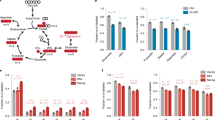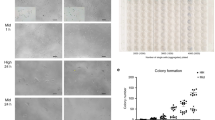Abstract
Distinctive properties of stem cells are not autonomously achieved, and recent evidence points to a level of external control from the microenvironment. Here, we demonstrate that self-renewal and pluripotent properties of human embryonic stem (ES) cells depend on a dynamic interplay between human ES cells and autologously derived human ES cell fibroblast-like cells (hdFs). Human ES cells and hdFs are uniquely defined by insulin-like growth factor (IGF)- and fibroblast growth factor (FGF)-dependence. IGF 1 receptor (IGF1R) expression was exclusive to the human ES cells, whereas FGF receptor 1 (FGFR1) expression was restricted to surrounding hdFs. Blocking the IGF-II/IGF1R pathway reduced survival and clonogenicity of human ES cells, whereas inhibition of the FGF pathway indirectly caused differentiation. IGF-II is expressed by hdFs in response to FGF, and alone was sufficient in maintaining human ES cell cultures. Our study demonstrates a direct role of the IGF-II/IGF1R axis on human ES cell physiology and establishes that hdFs produced by human ES cells themselves define the stem cell niche of pluripotent human stem cells.
This is a preview of subscription content, access via your institution
Access options
Subscribe to this journal
Receive 51 print issues and online access
$199.00 per year
only $3.90 per issue
Buy this article
- Purchase on Springer Link
- Instant access to full article PDF
Prices may be subject to local taxes which are calculated during checkout






Similar content being viewed by others
References
Scadden, D. T. The stem-cell niche as an entity of action. Nature 441, 1075–1079 (2006)
Thomson, J. A. et al. Embryonic stem cell lines derived from human blastocysts. Science 282, 1145–1147 (1998)
Xu, C. et al. Feeder-free growth of undifferentiated human embryonic stem cells. Nature Biotechnol. 19, 971–974 (2001)
Ludwig, T. E. et al. Derivation of human embryonic stem cells in defined conditions. Nature Biotechnol. 24, 185–187 (2006)
Hoffman, L. M. & Carpenter, M. K. Characterization and culture of human embryonic stem cells. Nature Biotechnol. 23, 699–708 (2005)
Stewart, M. H. et al. Clonal isolation of hESCs reveals heterogeneity within the pluripotent stem cell compartment. Nature Methods 3, 807–815 (2006)
Ying, Q. L., Nichols, J., Chambers, I. & Smith, A. BMP induction of Id proteins suppresses differentiation and sustains embryonic stem cell self-renewal in collaboration with STAT3. Cell 115, 281–292 (2003)
Dechiara, T. M., Efstratiadis, A. & Robertson, E. J. A growth-deficiency phenotype in heterozygous mice carrying an insulin-like growth factor II gene disrupted by targeting. Nature 345, 78–80 (1990)
Kauma, S. W. Cytokines in implantation. J. Reprod. Fertil. Suppl. 55, 31–42 (2000)
Heyner, S. Growth factors in preimplantation development: role of insulin and insulin-like growth factors. Early Pregnancy 3, 153–163 (1997)
Sperger, J. M. et al. Gene expression patterns in human embryonic stem cells and human pluripotent germ cell tumors. Proc. Natl Acad. Sci. USA 100, 13350–13355 (2003)
Levenstein, M. E. et al. Basic fibroblast growth factor support of human embryonic stem cell self-renewal. Stem Cells 24, 568–574 (2006)
Xu, R. H. et al. Basic FGF and suppression of BMP signaling sustain undifferentiated proliferation of human ES cells. Nature Methods 2, 185–190 (2005)
Dvorak, P. et al. Expression and potential role of fibroblast growth factor 2 and its receptors in human embryonic stem cells. Stem Cells 23, 1200–1211 (2005)
Xu, C. et al. Basic fibroblast growth factor supports undifferentiated human embryonic stem cell growth without conditioned medium. Stem Cells 23, 315–323 (2005)
Rosler, E. S. et al. Long-term culture of human embryonic stem cells in feeder-free conditions. Dev. Dyn. 229, 259–274 (2004)
Baserga, R., Peruzzi, F. & Reiss, K. The IGF-1 receptor in cancer biology. Int. J. Cancer 107, 873–877 (2003)
Hofmann, F. & Garcia-Echeverria, C. Blocking the insulin-like growth factor-I receptor as a strategy for targeting cancer. Drug Discov. Today 10, 1041–1047 (2005)
Tropepe, V. et al. Direct neural fate specification from embryonic stem cells: a primitive mammalian neural stem cell stage acquired through a default mechanism. Neuron 30, 65–78 (2001)
Vallier, L., Reynolds, D. & Pedersen, R. A. Nodal inhibits differentiation of human embryonic stem cells along the neuroectodermal default pathway. Dev. Biol. 275, 403–421 (2004)
Wang, L., Li, L., Menendez, P., Cerdan, C. & Bhatia, M. Human embryonic stem cells maintained in the absence of mouse embryonic fibroblasts or conditioned media are capable of hematopoietic development. Blood 105, 4598–4603 (2005)
Greber, B., Lehrach, H. & Adjaye, J. Fibroblast growth factor 2 transforming growth factor β signaling in mouse embryonic fibroblasts and human ESCs (hESCs) to support hESC self-renewal. Stem Cells 25, 455–464 (2007)
Huang, S. & Terstappen, L. W. Formation of haematopoietic microenvironment and haematopoietic stem cells from single human bone marrow stem cells. Nature 360, 745–749 (1992)
Huang, S. & Terstappen, L. W. Formation of haematopoietic microenvironment and haematopoietic stem cells from single human bone marrow stem cells. Nature 368, 664 (1994)
Lighten, A. D., Hardy, K., Winston, R. M. & Moore, G. E. Expression of mRNA for the insulin-like growth factors and their receptors in human preimplantation embryos. Mol. Reprod. Dev. 47, 134–139 (1997)
Chi, M. M., Schlein, A. L. & Moley, K. H. High insulin-like growth factor 1 (IGF-1) and insulin concentrations trigger apoptosis in the mouse blastocyst via down-regulation of the IGF-1 receptor. Endocrinology 141, 4784–4792 (2000)
Mohammadi, M. et al. Structures of the tyrosine kinase domain of fibroblast growth factor receptor in complex with inhibitors. Science 276, 955–960 (1997)
Inman, G. J. et al. SB-431542 is a potent and specific inhibitor of transforming growth factor-β superfamily type I activin receptor-like kinase (ALK) receptors ALK4, ALK5, and ALK7. Mol. Pharmacol. 62, 65–74 (2002)
Laping, N. J. et al. Inhibition of transforming growth factor (TGF)-β1-induced extracellular matrix with a novel inhibitor of the TGF-β type I receptor kinase activity: SB-431542. Mol. Pharmacol. 62, 58–64 (2002)
Orfao, A. et al. Flow cytometry in the diagnosis of cancer. Scand. J. Clin. Lab. Invest. Suppl. 221145–152 (1995)
Orfao, A. et al. Flow cytometry: its applications in hematology. Haematologica 80, 69–81 (1995)
Acknowledgements
S.C.B. is supported by a CIHR Canada Graduate Scholarship doctoral award; M.H.S. by a postgraduate scholarship award from the Stem Cell Network and CIHR Canada Graduate Scholarship doctoral award; and M.Bh. by the Canadian Chair Program who holds the Canada Research Chair in human stem cell biology and Michael G. DeGroote Chair in Stem Cell Biology. This work was supported by a grant from the Ontario Research and Development Challenge Fund (ORDCF) to G.L. and by CIHR and NCIC to M.Bh. We also are grateful for the help of L. Gallacher and R. Mondeh with culture assistance, the Krembil Centre at the Robarts and M. Sibly and J. Trowbridge for useful suggestions, and A. Nagy, J. Rossant, M. Gertsenstein, K. Vinterstein, M. Mileikovsky and J. Draper for providing the CA1 human ES cell line.
Author information
Authors and Affiliations
Corresponding author
Ethics declarations
Competing interests
Reprints and permissions information is available at www.nature.com/reprints. The authors declare no competing financial interests.
Supplementary information
Supplementary Information
This file contains Supplementary Figures 1-7 with Legends and Supplementary Tables 1-2. (PDF 9774 kb)
Rights and permissions
About this article
Cite this article
Bendall, S., Stewart, M., Menendez, P. et al. IGF and FGF cooperatively establish the regulatory stem cell niche of pluripotent human cells in vitro. Nature 448, 1015–1021 (2007). https://doi.org/10.1038/nature06027
Received:
Accepted:
Published:
Issue Date:
DOI: https://doi.org/10.1038/nature06027
This article is cited by
-
Glutamate secretion by embryonic stem cells as an autocrine signal to promote proliferation
Scientific Reports (2023)
-
Sensory nerve niche regulates mesenchymal stem cell homeostasis via FGF/mTOR/autophagy axis
Nature Communications (2023)
-
ZBTB12 is a molecular barrier to dedifferentiation in human pluripotent stem cells
Nature Communications (2023)
-
The adaptation of bovine embryonic stem cells to the changes of feeder layers
In Vitro Cellular & Developmental Biology - Animal (2023)
-
Molecular identification, expression pattern, and in-vitro bioactivity analysis of insulin-like growth factor 2 in olive flounder Paralichthys olivaceus
Journal of Oceanology and Limnology (2023)
Comments
By submitting a comment you agree to abide by our Terms and Community Guidelines. If you find something abusive or that does not comply with our terms or guidelines please flag it as inappropriate.



